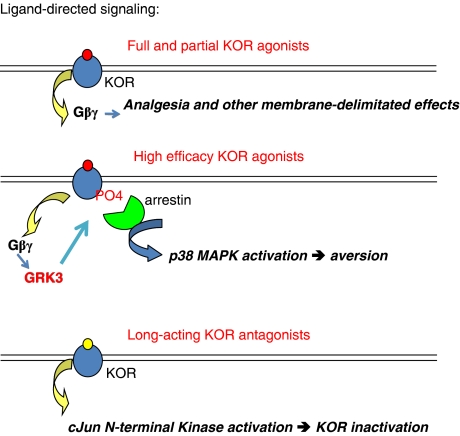When the κ-subtype of opioid receptor was first distinguished, there was tremendous interest in developing analgesics that would provide pain-relief without activating the reward pathways stimulated by morphine-like μ-opioids. A nonaddictive opioid has been a holy grail of medicinal chemistry ever since Friedrich Serturner isolated morphine from opium in 1804. Selective κ-agonists were developed, but quickly found to produce different problems including dysphoria, diuresis, and constipation. In addition, their maximal analgesic effects were weaker than μ-opioids in rodents. But interest in κ-opioids as therapeutic tools did not completely die; Shippenberg and colleagues found that κ-agonists reduced the rewarding effects of co-administered addictive drugs; κ-opioid analgesia using pentazocine was seen as an alternative for pain control in people with a risk of drug abuse; and κ-agonists entered clinical trials for the treatment of pain and itch (see Millan, 1990).
Although enthusiasm for agonists waned, interest in κ-antagonists as therapeutic tools got a boost when Carlezon and colleagues showed their activity in the forced swim assay, predictive of antidepressant activity (Mague et al, 2003). Following on that study, we reported that κ-antagonism blocked stress-induced potentiation of cocaine reinforcement (McLaughlin et al, 2003). Numerous studies have replicated and extended those findings showing the utility of κ-antagonists to block stress-induced reinstatement of extinguished cocaine- and ethanol-seeking, block μ-opioid and cannabinoid withdrawal signs, and block the aversive effects of nicotine. All these effects of κ-antagonists can be attributed to block of the actions of endogenous dynorphins, which are κ-selective opioid peptides released during the stress response (Land et al, 2008). Consistent with the dysphoric effects of κ-agonist drugs and natural κ-opioids isolated from the plant Salvia divinorum, endogenous dynorphins encode a component of the anxiogenic and dysphoric responses to stressful experience.
Thus, κ-opioid antagonists show promise as therapeutic tools to promote stress resilience that may be effective in treating certain forms of anxiety, depression, and addiction disorders, as stress-hypersensitivity exacerbates each of these syndromes. However, selective κ-opioid antagonists have been known since their initial development by Portoghese and Takemori more than 20 years ago to have remarkably long durations of action. Although this property might be considered a therapeutic advantage (as infrequent dosing may be sufficient and missed doses would be less concerning), the lack of understanding of its basis has slowed drug development. We recently reported (Bruchas et al, 2007; Melief et al, 2010) that the long action was not a result of κ-receptor downregulation or drug persistence, but rather that these ligands were not truly competitive antagonists; instead their effects were caused by the activation of c-Jun N-terminal kinase (JNK) following κ-receptor binding (Figure 1). We think that JNK activation phosphorylates a component of the κ-receptor signaling complex, thus preventing G-protein activation and causing long-lasting receptor inactivation. This mechanism predicts that low-efficacy ligands that bind to κ-receptors without activating JNK may be short-acting antagonists. Conventional, competitive κ-antagonists may more easily gain approval.
Figure 1.
Three possible forms of ligand-directed signaling are illustrated.
The therapeutic promise of κ-agonists has also been recently revived by studies showing that their dysphoric effects require activation of G-protein receptor kinase, arrestin recruitment and subsequent p38 MAPK activation, whereas their analgesic effects do not (Bruchas and Chavkin, 2010). As evident from ligands initiating μ-opioid signaling, some analgesic opioids including fentanyl effectively recruit arrestin, whereas morphine is an excellent analgesic, but does not recruit arrestin. The realization that different agonists binding to the same receptor can produce different actions has been variously called ‘biased agonism', ‘functional selectivity', and ‘ligand directed signaling' (see Melief et al, 2010). On the basis of this concept, an analgesic κ-opioid that did not recruit arrestin might not produce dysphoria (Figure 1). A formulation of such a ligand, combined with a peripherally restricted κ-antagonist to block the constipating and diuretic effects, might result in the long-sought nonaddictive opioid analgesic. These are exciting times in the κ-world.
C Chavkin has no conflicts of interest or consulting relationships to disclose, but has received outside compensation for seminars on his NIH-funded research during the past 3 years at: AstraZeneca, NIDA, UC Irvine, Uniformed Services University, University of Minnesota, Sepracor, Eli Lilly, Adolor, and Vanderbilt. In addition, he has received outside compensation for reviewing grants for CSR-NIH and NIDA.
References
- Bruchas MR, Chavkin C. Kinase cascades and ligand-directed signaling at the kappa opioid receptor. Psychopharmacology (Berl) 2010;210:137–147. doi: 10.1007/s00213-010-1806-y. [DOI] [PMC free article] [PubMed] [Google Scholar]
- Bruchas MR, Yang T, Schreiber S, Defino M, Kwan SC, Li S, et al. Long-acting kappa opioid antagonists disrupt receptor signaling and produce noncompetitive effects by activating c-Jun N-terminal kinase. J Biol Chem. 2007;282:29803–29811. doi: 10.1074/jbc.M705540200. [DOI] [PMC free article] [PubMed] [Google Scholar]
- Land BB, Bruchas MR, Lemos JC, Xu M, Melief EJ, Chavkin C. The dysphoric component of stress is encoded by activation of the dynorphin kappa-opioid system. J Neurosci. 2008;28:407–414. doi: 10.1523/JNEUROSCI.4458-07.2008. [DOI] [PMC free article] [PubMed] [Google Scholar]
- Mague SD, Pliakas AM, Todtenkopf MS, Tomasiewicz HC, Zhang Y, Stevens WC, Jr, et al. Antidepressant-like effects of kappa-opioid receptor antagonists in the forced swim test in rats. J Pharmacol Exp Ther. 2003;305:323–330. doi: 10.1124/jpet.102.046433. [DOI] [PubMed] [Google Scholar]
- McLaughlin JP, Marton-Popovici M, Chavkin C. Kappa opioid receptor antagonism and prodynorphin gene disruption block stress-induced behavioral responses. J Neurosci. 2003;23:5674–5683. doi: 10.1523/JNEUROSCI.23-13-05674.2003. [DOI] [PMC free article] [PubMed] [Google Scholar]
- Melief EJ, Miyatake M, Bruchas MR, Chavkin C. Ligand-directed c-Jun N-terminal kinase activation disrupts opioid receptor signaling. Proc Natl Acad Sci USA. 2010;107:11608–11613. doi: 10.1073/pnas.1000751107. [DOI] [PMC free article] [PubMed] [Google Scholar]
- Millan MJ. Kappa-opioid receptors and analgesia. Trends Pharmacol Sci. 1990;11:70–76. doi: 10.1016/0165-6147(90)90321-x. [DOI] [PubMed] [Google Scholar]



